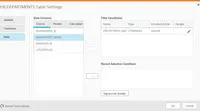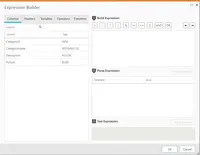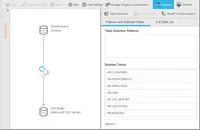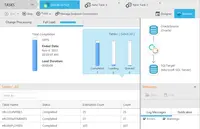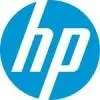Overview
What is Qlik Replicate?
Qlik Replicate enables organizations to accelerate data real-time replication, ingestion and streaming via change data capture, across a wide range of heterogeneous databases, data warehouses and data lake platforms.
Qlik Replicate is a fantastic tool for replicating data between databases.
Easy data streaming with Qlik Replicate
Data Replication easily with a few clicks
Replication Master.
Qlic replicate for a small/medium company.
Data Engineer and Application Developer Review
Previously, we had lots issue regarding replication of …
Qlik Replicate
Quick solution out of the box but limited
Data Replication is just a CLICK with Qlik Replicate
Qlik Replication at a Retailer
Qlik Replicate Review
Good and reliable replication software
Qlik Replicate delivers data fast for quick discovery and analysis
Build data pipelines quickly with Replicate
Oracle and Salesforce replication to MS SQL Server made easy
Awards
Products that are considered exceptional by their customers based on a variety of criteria win TrustRadius awards. Learn more about the types of TrustRadius awards to make the best purchase decision. More about TrustRadius Awards
Pricing
What is Qlik Replicate?
Qlik Replicate enables organizations to accelerate data real-time replication, ingestion and streaming via change data capture, across a wide range of heterogeneous databases, data warehouses and data lake platforms.
Entry-level set up fee?
- Setup fee required
Offerings
- Free Trial
- Free/Freemium Version
- Premium Consulting/Integration Services
Would you like us to let the vendor know that you want pricing?
70 people also want pricing
Alternatives Pricing
What is Oracle GoldenGate?
Oracle GoldenGate is database management software for data integration, and availability support for heterogeneous databases.
What is Hornetsecurity VM Backup?
Hornetsecurity VM Backup (formerly Altaro) is a backup and replication solution for Hyper-V and VMware virtual machines. VM Backup can manage large infrastructures, with the revamped backup repository providing long-term storage and more efficient use of disk space.
Product Details
- About
- Integrations
- Competitors
- Tech Details
- FAQs
What is Qlik Replicate?
Qlik Replicate is Enterprise-Ready. It moves data at high speed from source to target and offers a single pane of glass monitoring of data pipelines across the enterprise, all managed through a graphical interface that automates end-to-end replication. With agentless configuration, administrators and data architects can set up, control, and monitor bulk loads and real-time updates with automated change data capture (CDC) at scale.
Qlik Replicate Screenshots
Qlik Replicate Video
Qlik Replicate Integrations
- Qlik Catalog
- Qlik Compose
- Qlik Enterprise Manager
Qlik Replicate Competitors
Qlik Replicate Technical Details
| Deployment Types | On-premise |
|---|---|
| Operating Systems | Windows, Linux |
| Mobile Application | No |
| Supported Countries | Global |
| Supported Languages | English |
Frequently Asked Questions
Comparisons
Compare with
Reviews and Ratings
(49)Community Insights
- Business Problems Solved
- Pros
- Cons
- Recommendations
Qlik Replicate has been widely used by organizations to simplify and streamline their data integration procedures. Users have reported that this tool effectively transfers data from one place to another, improving overall performance and efficiency in the data integration process. One of the primary use cases for Qlik Replicate is ensuring the accuracy and timeliness of data across various storage systems, which is crucial for organizations relying on real-time data analysis for making informed business decisions. Customers have found value in using Qlik Replicate for data warehousing, disaster recovery, cloud migration, and analytics purposes. This powerful tool allows for data replication, synchronization, and integration across multiple databases and storage systems. Users have successfully replicated operational application data from various sources such as Oracle ERP and Salesforce to Microsoft SQL Server BI systems, enhancing business case data pipelines and supporting reporting and dashboards. Additionally, Qlik Replicate has simplified the process of data warehousing and batch processing of streaming data, making it more convenient for users. Organizations have utilized Qlik Replicate to replicate data from brick-and-mortar source system databases to cloud databases, allowing for direct data querying and supporting various reporting needs. Users have also praised Qlik Replicate for its reliability, intuitive user interface, and support for a variety of sources and targets, making it a preferred choice for replicating on-premises data into the cloud. Overall, customers from different segments and sizes have found Qlik Replicate to be a fantastic tool for achieving seamless data replication with ease of configuration, scalability, and customization options.
Stability and reliability: Users have consistently praised Replicate for its stability and reliability, with minimal alerts, failures, or troubleshooting required. Several reviewers have mentioned this as a key benefit of using the software.
Ease of scalability: Many users have found Replicate to be highly scalable in big data integrated projects, which has had a positive financial impact for them. The ability to easily add new source tables to tasks and ensure synchronization with the latest data has been particularly appreciated by users.
Efficiency in handling large amounts of data: Replicate's ability to efficiently handle and capture large amounts of data has been highlighted by multiple reviewers. This makes it a valuable tool for data replication, warehousing, disaster recovery, cloud migration, and analytics tasks.
Latency Issues: Some users have experienced latency in certain tasks and are unsure of the cause. This issue has been mentioned by multiple reviewers, indicating a recurring problem that affects the overall performance and efficiency of the tool.
Limited Documentation and Error Reporting: Several reviewers have expressed the need for more comprehensive documentation and detailed error reporting in the tool. The lack of sufficient documentation makes it difficult for users to troubleshoot issues effectively, leading to frustration and wasted time trying to find solutions.
Challenging Support Experience: Users have voiced their desire for more agile and efficient support. They find the current support experience lacking in responsiveness and quality, highlighting areas that require improvement such as faster response times, better communication, and more knowledgeable support staff.
Users have made several recommendations based on their experiences with Qlik Replicate. Firstly, they suggest trying Qlik Replicate for change data capture (CDC) needs and conducting a proof of concept (POC) to see the benefits and suitability of the software.
Secondly, it is advised to check the hardware requirements, install recommended resources, and test the software in a representative environment with volume. Users also recommend considering any pre-requests, security requirements, and logging setup.
Lastly, many users find Qlik Replicate worth the cost and believe it is an excellent tool for reducing stress during data replication or loading. They suggest getting a demo of the software to better understand its capabilities and determine if it suits the company's needs.
Attribute Ratings
Reviews
(1-17 of 17)Easy data streaming with Qlik Replicate
- Real time integration
- User experience
- Performance
- Data mapping
- Integration with external custom code
Data Replication easily with a few clicks
The main use case for Qlik Replicate is to ensure that data is accurate and up-to-date across my organization's various data storage systems. This is particularly important for organizations that rely on real-time data analysis to inform business decisions, as Qlik Replicate ensures that all relevant data is available for analysis in a timely manner. Some common ways that Qlik Replicate is used include:Data Warehousing: Qlik Replicate can be used to replicate data from operational databases to data warehouses for analysis.Disaster Recovery: Qlik Replicate can be used to replicate data in real-time to a secondary location for disaster recovery purposes.Cloud Migration: Qlik Replicate can be used to move data from on-premises systems to cloud-based systems.Analytics: Qlik Replicate can be used to move data from various sources into a single location for analysis.Overall, Qlik Replicate is a versatile tool that can be used to ensure that data is accurate and up-to-date across an organization's various data storage systems.
- Data Warehousing: Qlik Replicate can be used to replicate data from operational databases to data warehouses for analysis.
- Disaster Recovery: Qlik Replicate can be used to replicate data in real-time to a secondary location for disaster recovery purposes.
- Cloud Migration: Qlik Replicate can be used to move data from on-premises systems to cloud-based systems.
- Analytics: Qlik Replicate can be used to move data from various sources into a single location for analysis.
- More detailed documentation with errors that occurred in the tool.
- More agile and efficient support.
- It works best if you also use other Qlik products.
- Few APi integrations are not compatible
If the data source is MongoDB, it is more complicated and currently there is no possibility of sending data to MongoDB.
Qlik Replication at a Retailer
- Replication rate
- Performance
- Easy to configure
- Pricing
- Support
Good and reliable replication software
- Performing near-real time replications for 14TB SQL Server DB into Azure EDW
- Performing near real time replications from 28TB on-prem Oracle DB into Azure EDW
- Looking for Qlik to support CDS view replications from S4 HANA, both full loads and CDC
- Better document data transformation functionality
Qlik Replicate delivers data fast for quick discovery and analysis
- Many different source to target replication options
- Common UI on Linux and Windows
- Lots of task tuning options
- Robust API (Enterprise Manager)
- Easy to use UI
- Robust scheduler
- I would like to be able to keep task history beyond 30 days for viewing in analytics.
- I would like integrations to more than email. Say, MSFT Teams channels.
- Logging is great. With known resolutions to errors that are encountered it would be great to have more detailed context-sensitive help for faster resolution of errors. Especially if they are well known in the community.
- I would like integration to source control for our at least our tasks.
Oracle and Salesforce replication to MS SQL Server made easy
- Flexibility for creating multiple tasks for grouping related tables
- Table level filters
- The scheduler feature has been very useful
- The scheduler, while useful, has issues when trying to create or adjust a schedule more recent than the current time UTC. That is the one thing I would really like to see improved.
- Real time replication using Database Logs
- Speed to setup and make it operational
- Speed to business value realization
- Applying the solution to SAP/HANA and other databases as source
- Connectors/Adaptors to Tier 1 Cloud applications
- Data type portability across multiple databases
- Replication
- Reliability
- Incremental Speed
- Full reload speed
- Features such as parallel processing are not working
- If connection is lost, a full reload is required to re-sync
Use Qlik Solutions for Data at your fingertips!
- intuitive interface
- reliable data
- helpful support when needed
- smoother interface
- faster load times
- enhanced funtionality
Qlik Replicate to the rescue for Change Data Captures
- Data ingestion.
- Real-time analytics.
- Replicating/syncing source data (CRUD operations).
Qlik Replicate is an efficient ETL product
- Reliably and quickly delivers data to and from a wide variety of endpoints.
- Support staff responds quickly and helpfully to support requests and questions.
- API coverage in Enterprise Manager allows for automation of administrative tasks.
- The base Replicate web GUI is lacking. If you have dozens or more tasks, it's hard to get a sense of how they're performing. Enterprise Manager solves all of these problems but is a separate install.
- The support portal is extremely difficult to navigate. It's hard to track down exactly what you're looking for.
- It would be helpful to have better documentation and example queries for the tables in the Enterprise Manager analytics database.
- Destination databases that don't support common DDL commands behave unpredictably. And the replication of schema changes isn't consistent.
Qlik Data Replication reduces friction in ETL
- Loads data from ERP systems.
- Non journaled/logged sources can be run as full load only processes via API calls.
- Monitoring and alerting.
- Ability to enable source system owners to start and stop tasks for their maintenance windows.
- A wizard for partitions for parallel loading.
- Better way to analyze latency.
- Better documentation for using flat files as a source.
Experience the miracle in QLIK using few clicks
- Low latency.
- High volume data.
- Easiness of monitoring.
- Alerting mechanism.
- Less impact on the source.
- Hourly schedule.
- Source to target comparison.
- Renaming tasks.
Simple, yet powerful tool
It's being used by multiple departments in the whole organization.
It helps in full load and replication.
- Change processing option to replicate real time
- Various connection end points
- Load monitor windows
- Easy to learn and use
- Error message clarity is lacking and not easy to understand
- Logs aren't user friendly to read
- No downloadable client
Doesn't do well with new connection end points like Salesforce.
Utilize Qlik Replicate to Streamline Your Data Into Your Data Warehouse and Build Your BI Platform Faster!
- Replicate is extremely stable and does not generate a lot of alerts/failures/issues that take up time to troubleshoot.
- It is very easy to add new source tables to a Replicate task so that we're always in sync with new data available from the CRM.
- It's nice that Qlik Replicate also allows you to create a job to stop and then restart your tasks during maintenance windows that occur on both the source and target systems.
- I wish there was a way to give the user the option to decide if changing a particular task setting actually requires a reload of the target table. Too many changes or modifications within the task settings require you to reload a table and if the target database and source database do not have the same data retention policies then you risk losing data and you have to account for that when changing task settings.
- From time to time a particular task begins to build up latency where it becomes 2,3 or 4 hours behind the source system. It's never really clear why that is occurring and it may be impossible to know exactly but I wish there was a way to know that it was due to activity happening at the source or the target.
Good solution for keeping data sources synced
- Replicate data from external sources to an internal data lake.
- Keep data in sync from one source to another collective source, regardless of the sources in question.
- Perform near-real-time tasks and replications as required, but this is adjustable because some of our replications are only meant to provide data that is not less than 24 hours old.
- In the beginning of our partnership, support was a real challenge. It has improved over the last three years, but there is still more room for improvement.
- The learning curve is steep and it is hard to find a replication specialist, so Interstate was forced to train someone in house, and there were growing pains there.
- Cost is always an area for improvement, although, in my opinion, at least for Interstate, cost is reasonable.
Satisfied Qlik Replicate Veteran
- Very low latency with large transaction volume.
- Central management console (AEM) for monitoring and managing many tasks.
- No daily maintenance. Process is basically on autopilot.
- Quick and easy to create or modify tasks.
- Filtering data had some unwanted side effects.
- No ability to do full loads with bidirectional replication.
- Ability to use LOBs with upsert mode.
- No ability to push/pull from web services/APIs

